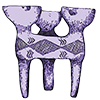Women Representations in Spaces of ‘‘The Handmaid's Tale’’ Series
DOI:
https://doi.org/10.33831/jws.v24i2.443Keywords:
toplumsal cinsiyet, kadın mekânsal temsil, sinematik mekân, Damızlık Kızın ÖyküsüAbstract
The series ‘The Handmaid's Tale’ refers to the power relations between the body and social structure, demonstrating the relation-ship of domination in which both societal norms and power dynamics shape an individu-al's body. Therefore, representations within the show's setting play a significant role in how individuals' bodies are perceived and utilized, concerning factors such as gender, class, race, and others. The research aims to examine the representations of women in fictional interior spaces of a digital media series which will contribute to many disciplines, gender studies, cinematography, and interior architecture.
The research focuses on the Waterford House from the first season of ‘The Handmaid's Tale’ as a means of cinematic spatial analysis. The analysis of the set design, spatial elements, arrangements, actions, symbolic meanings, the reflection of social norms in the framing, and the theoretical backgrounds of the characters all incorporate cinematographic language. The study's goal is to examine the meanings at-tached to cinematic space to revitalize varied norms of women's representations and norma-tive stereotypes of the community.
The results of this study's spatial analysis will shed light on both the representation of gender roles depicted within the fictional culture, time, and location of the series and contribute to future studies on gender and space, considering the prevailing norms of today and beyond. By emphasizing the limita-tions faced by women in social life, it is hoped that it would contribute to raising awareness of women's rights and gender inequality in society.
References
Atwood, M. (2004). The Handmaid's Tale and Oryx and Crake in Context. PMLA, 119(3), 513-517. https://doi.org/10.1632/003081204X20578
Atwood, M. (2019 [1985]). Damızlık Kızın Öyküsü. (Çev. S. Altınçekiç ve Ö. Kabakçıoğlu). İstanbul: Doğan Kitap.
Baydar, G. (2012). Sexualised productions of space. Gender, Place and Culture, 19(6), 699–706. https://doi.org/10.1080/0966369X.2012.675472
Beauvoir, S. (1986). Kadın: İkinci Cins. İçinde, B. Onaran, (Ed.). İstanbul: Payel Yayınevi.
Beşışık, G. (2013). Sinema ve mimarlıkta mekân kurgusu ve kavrayışı (Doktora tezi) Dokuz Eylül Üniversitesi, İzmir.
Butler, J. (1988). Performative Acts and Gender Constitution: An Essay in Phenomenology and Feminist Theory. Theatre Journal, 40(4), 519-531.
Butler, J. (2014 [1989]). Cinsiyet Belası: Feminizm ve Kimliğin Altüst Edilmesi. (Çev. B. Ertür). İstanbul: Metis Yayınevi.
Connell, R.W. (2005). Masculinities. California: University of California Press.
Der-Ohannesian, N. (2021). Female Negotiations of Affect in Domestic and Public Space in the Television Series The Handmaid’s Tale. Ilha do Desterro, 74, 577-588. https://doi.org/10.5007/2175-8026.2021.e75830
Douglas, S., & Michaels, M. (2005). The mommy myth: The idealization of motherhood and how it has undermined all women. Simon and Schuster.
Dray, K. (2018). The making of The Handmaid’s Tale. Retrieved from https://www.stylist.co.uk/long-reads/the-handmaids-tale-season-2-behind-the-scenes-making-of-spoilers-tv-channel-4/205316
Falahat, M. (2006). Sense of place and the factors shaping it. Fine Arts Magazine, 26.
Gökçen, N. (2014). Homo Ludens Gilead’da: The Handmaid’s Tale’e Yeni Bir Bakış. Atatürk Üniversitesi Sosyal Bilimler Enstitüsü Dergisi, 18 (2), 139-155.
Grosz, E. (2001). Architecture from the outside: Essays on virtual and real space. MIT Press.
Hanisch, C. (2006 [1969]). The Personal is Political. The Women's Libreration Movement classic with a new explanatory introduction.
Hayden, B. (1992). Observing prehistoric women. In Exploring Gender through Archaeology: Selected Papers from the 1991 Boone Conference. 33-48. Prehistory.
Heynen, H. (2011). Gender and architecture. A review of the literature. Journal of the School of Architecture at the University of Cyprus, 2, 158-177.
Hooks, B. (2014). Yearning: Race, Gender, and Cultural Politics. Routledge.
Lefebvre, H. (1991). Production of Space. USA: Blackwell.
Massey, D. (1994). Space, Place, and Gender. In Space, Place, and Gender (pp. 185-190). University of Minnesota Press.
McDowell, L. (1993). Space, place, and gender relations: Part I. Feminist empiricism and the geography of social relations. Progress in Human Geography, 17(2), 157–179. https://doi.org/10.1177/030913259301700202
Miller, B. (Producer). (2017). The Handmaid's Tale [TV series]. MGM Television; Hulu.
Natalia, V. M. (2019, October 15). The Handmaid’s Tale: Symbolism of the House. Retrieved from https://medium.com/astral-dandelion/the-handmaids-tale-symbology-of-the-house-27eca18f67a7
Øverland, O. (2021). The Female Body in Atwood’s Gilead: A Material Feminist Reading of the Female Body in The Handmaid’s Tale, The Handmaid’s Tale TV Show and The Testaments (Master's thesis).
Pallasmaa, J. (2012). The Architecture of Image: Existential Space in Cinema. Phainomenon, 25(1), 157-174.
Rendell, J. (2000). Introduction: ‘gender, space’. In Gender space architecture: An Interdisciplinary Introduction, 101-111. Routledge.
Robinson, A. (2019). The Art and Making of The Handmaid's Tale: The Official Companion to MGM Television's Hit Series. Insight Editions. Retrieved from https://www.previewsworld.com/Catalog/FEB191815
Stamp, E. (2017, May 16). 7 Secrets of The Handmaid’s Tale Set That Send a Message. Architectural Digest. Retrieved from https://www.architecturaldigest.com/story/7-secrets-of-the-handmaids-tale-set-that-send-a-message
Tolan, F. (2007). Margaret Atwood: Feminism and Fiction. New York: Rodopi.
Woolf, V. (2002 [1929]). Kendine Ait Bir Oda. İstanbul: İletişim Yayınları.
Downloads
Published
Issue
Section
License
Copyright (c) 2024 Kadın/Woman 2000, Journal for Women's Studies

This work is licensed under a Creative Commons Attribution-NonCommercial 4.0 International License.
Authors who publish with this journal agree to the following terms:
- Authors retain copyright and grant the journal right of first publication, with the work [6 months] after publication simultaneously licensed under a Creative Commons Attribution License that allows others to share the work with an acknowledgement of the work's authorship and initial publication in this journal.
- Authors are able to enter into separate, additional contractual arrangements for the non-exclusive distribution of the journal's published version of the work (e.g., post it to an institutional repository or publish it in a book), with an acknowledgement of its initial publication in this journal.
- Authors are permitted and encouraged to post their work online (e.g., in institutional repositories or on their website) prior to and during the submission process, as it can lead to productive exchanges, as well as earlier and greater citation of published work (See The Effect of Open Access)







